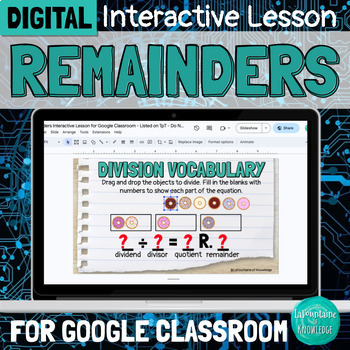DIGITAL Basic Division with Remainders Interactive Lesson for Google Classroom
- Google Slides™

Also included in
- This collection of 7 interactive math lessons for Google Classroom is perfect to introduce or review basic multiplication and division. Each lesson includes:video lessons (YouTube and Loom viewing options)practice problems and activitiesanswer keysThese lessons are ready to assign and easy for studePrice $18.02Original Price $25.75Save $7.73
Description
This interactive Google Slides lesson introduces students to important division vocabulary: divisor, dividend, quotient, and remainder. It also demonstrates strategies for solving basic division problems with remainders including concrete modeling with manipulatives, drawing pictures, and using fact families and counting on. 10 practice problems are included.
To complete the lesson students will:
- watch a 7 minute video lesson (YouTube and Loom included)
- solve 4 problems dragging and dropping objects to divide and then filling in the parts of the equation (dividend, divisor, quotient, and remainder) to demonstrate their understanding of division vocabulary
- solve 2 problems using concrete modeling to divide by dragging and dropping craft pom poms into cups
- solve 1 problem drawing a picture to divide by dragging and dropping circles and tally marks
- solve 3 problems using fact families to divide
Assign this ready-to-go interactive lesson through Google Classroom (be sure to make a copy for each student so they can edit) and enjoy all the time you just saved!
This lesson is part of an interactive unit that covers concrete modeling of multiplication and division, strategies for multiplying and dividing, division vocabulary, strategies for basic division with remainders, factors and multiples, prime and composite numbers, and properties of multiplication (identity, zero, commutative, and distributive). Check out some of the other great topics or buy the bundle and save 30%!
Please follow my store here for more great resources!
You can also find me on Facebook, Instagram, and lafountaineofknowledge.com where you'll discover ideas, inspiration, and plenty of freebies! Or join my email list to get a monthly newsletter with exclusive FREE resources you can't get anywhere else!
Want free money to spend on Teachers Pay Teachers? Rate this product to earn some TpT credit! Leaving feedback helps us both out and takes less than a minute! Your support makes it possible for me to continue making and sharing great resources! Thank you!






